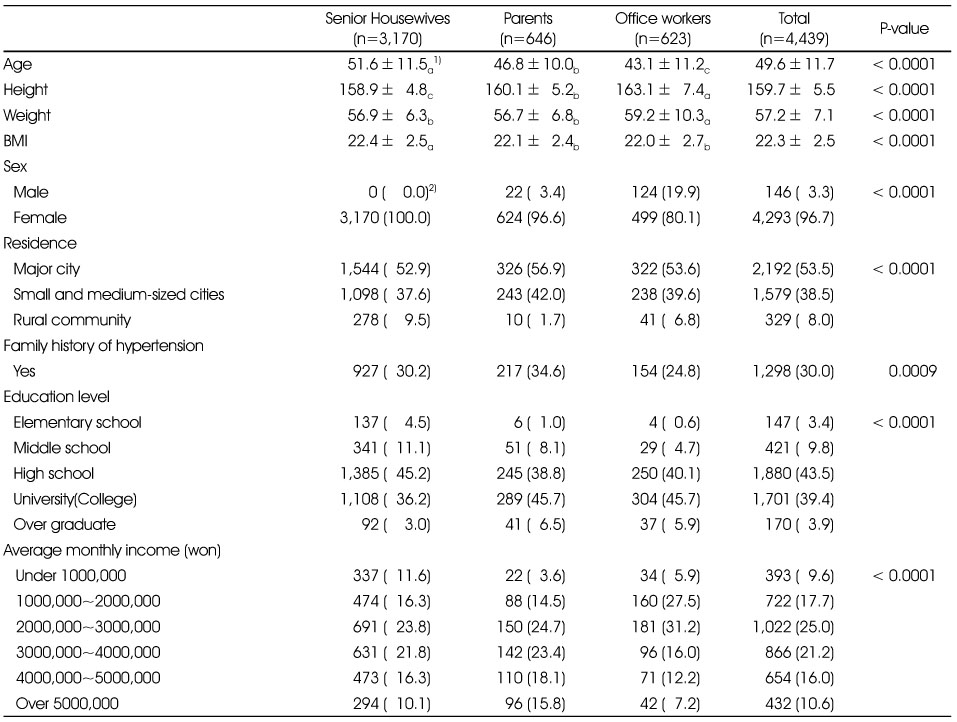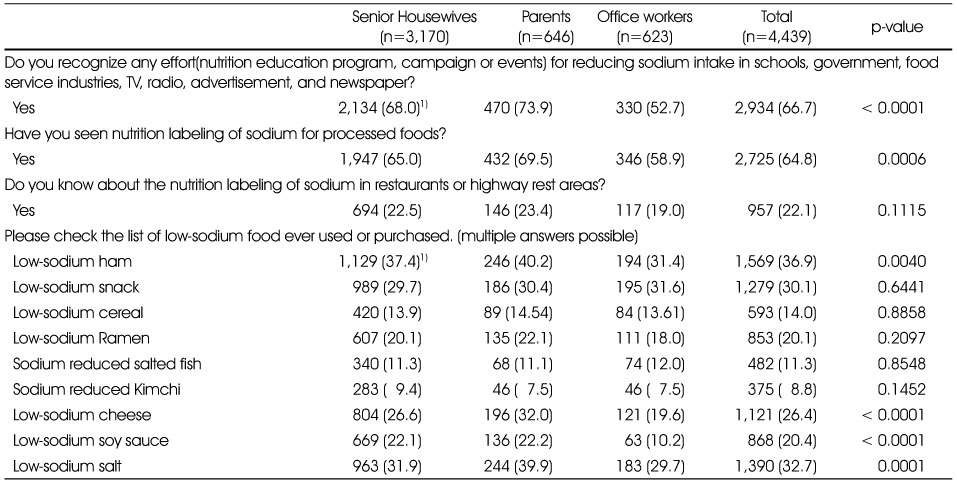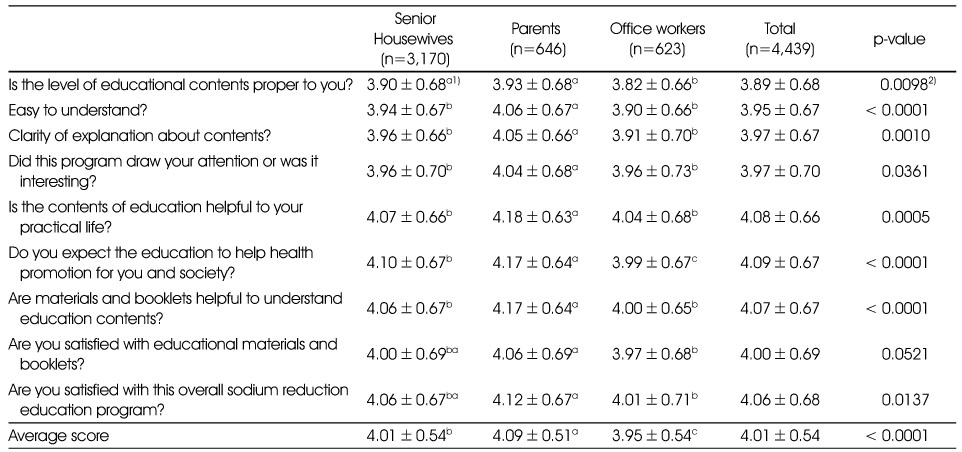Articles
- Page Path
- HOME > Korean J Community Nutr > Volume 20(6); 2015 > Article
-
Research Article
- Evaluation of Consumer Nutrition Education Program to Reduce Sodium Intake Based on Social Cognitive Theory
- So-Hyun Ahn, Jong Sook Kwon, Kyung Min Kim, Jin-Sook Yoon, Hye-Kyeong Kim
-
Korean Journal of Community Nutrition 2015;20(6):433-446.
DOI: https://doi.org/10.5720/kjcn.2015.20.6.433
Published online: December 31, 2015
1Department of Food Science & Nutrition, The Catholic University of Korea, Bucheon, Korea.
2Department of Food and Nutrition, Shingu College, Songnam, Korea.
3Department of Food and Nutrition, Baewha Women's University, Seoul, Korea.
4Department of Food and Nutrition, Keimyung University, Daegu, Korea.
- Corresponding author: Hye-Kyeong Kim. Department of Food Science & Nutrition, The Catholic University of Korea, 43 Jibongro, Wonmi-gu, Bucheon-si, Gyeonggi 14662, Korea. Tel: (02) 2164-4314, Fax: (02) 2164-4314, hkyeong@catholic.ac.kr
Copyright © 2015 The Korean Society of Community Nutrition
This is an Open-Access article distributed under the terms of the Creative Commons Attribution Non-Commercial License (http://creativecommons.org/licenses/by-nc/3.0/) which permits unrestricted non-commercial use, distribution, and reproduction in any medium, provided the original work is properly cited.
- 898 Views
- 11 Download
- 4 Crossref
Figure & Data
REFERENCES
Citations

- Consumer acceptance of reduced sodium white and multigrain bread: Impact of flavor enhancement and ingredient information on sample liking
Aubrey N. Dunteman, Soo‐Yeun Lee
Journal of Food Science.2023; 88(1): 417. CrossRef - The frequency of convenience food consumption and attitude of sodium and sugar reduction among middle and high school students in Seoul: a descriptive study
Seoyeon Park, Yeonhee Shin, Seoyeon Lee, Heejung Park
Korean Journal of Community Nutrition.2023; 28(4): 269. CrossRef - Development and evaluation of a nutrition education program for housewives to reduce sodium intake: application of the social cognitive theory and a transtheoretical model
Sohyun Ahn, Jong-Sook Kwon, Kyungmin Kim, Hye-Kyeong Kim
Journal of Nutrition and Health.2022; 55(1): 174. CrossRef - Customers' Perceptions of Operational Status of and Needs for Sodium Reduction in the Industry Foodservice in Seoul
Na-Young Yi
Korean Journal of Community Nutrition.2020; 25(1): 21. CrossRef
Regional distribution of the subjects participated in the educational program
1) N (%): subtotal population of local unit
2) N (%): subtotal education times of local unit
3) N (%): subtotal participated subjects of local unit
The demographic characteristics of the study subjects
1) Mean ±SD: Mean values with different letters within a row are significantly different by Duncan's multiple range test after one way ANOVA
2) N (%)
Perception of environmental factors related to salt reduction and experience of low sodium product
1) N (%): The response number and rate of 'yes' to each item
The change of positive outcome expectation of reducing sodium intake
1) P value from chi-square test by subject group in each category at the baseline
2) P value from chi-square test by subject group in each category after nutrition education
3) Q1: Decrease of blood pressure, Q2: Prevention to stroke and heart diseases, Q3: Weight loss, Q4: Reduction of swelling in body, Q5: Skin enhancement, Q6: Prevention to osteoporosis, Q7: Prevention to cancer
4) N (%): The response number and rate of 'yes' in each item.
5) P value from chi-square test in each item of same subject group (*: p < 0.05, **: p < 0.01, ***: p < 0.001)
The change of negative barriers to practice reducing sodium intake
1) P-value from ANCOVA adjusted by age, sex, height and weight among subject group in each category at the baseline
2) P-value from ANCOVA adjusted by age, sex, height and weight among subject group in each category after nutrition education
3) Q1:Bad taste, Q2:Hard to prepare and cook, Q3:Limitation to choose food, menu and restaurant, Q4:Limited information, knowledge and skills to practice Q5:Interference with to social relationship when dining with family and friends, Q6:Preference to broth dishes (soup, stew), Q7:Preference to Kimchi, salted fish, fermented sauces
4) Mean±SD, Mean values with different superscripts are significantly different among the groups at baseline(before) at α=0.05 as determined by Duncan's multiple range test The lower score means less barriers to practice reducing sodium intake (1=very hard to agree, 2=hard to agree, 3=agree a little, 4=agree, 5=agree a lot)
5) P from paired t-test in each subject group (*: p < 0.05, **: p < 0.01, ***: p < 0.001)
The change of subjects' perceptions and self-efficacy related to reducing sodium intake
1) P-value from ANCOVA adjusted by age, sex, height and weight among subject group in each category at the baseline
2) P-value from ANCOVA adjusted by age, sex, height and weight among subject group in each category after nutrition education
3) Q1:I feel unfulfilled or unsatisfied when eating foods with less salt, Q2:I usually recognize the sodium contents in food or dish, Q3:Practicing low-sodium diet will improve my health status, Q4:I will buy fresh food rather than processed or instant food, Q5:I will request less salty when eating-out, Q6:I will choose dishes with native flavor and taste rather than hot, salty, spicy one, Q7:I will have concern for low-sodium recipe. Q8:I think that influence of consumers' sodium reduction can induce the change of social surroundings.
4) Mean±SD. Mean values with different superscripts and subscripts are significantly different among the groups at baseline (before) and after nutrition education, respectively, at α=0.05 as determined by Duncan's multiple range test. The higher score means better perceptions and self-efficacy (1=very hard to agree, 2=hard to agree, 3=agree a little, 4=agree, 5=agree a lot. The 1'st question was coded conversely)
5) P from paired t-test in each subject group (*: p < 0.05, **: p < 0.01, ***: p < 0.001)
The change of subjects' knowledge for behavioral capability to reduce sodium intake
1) P-value from chi-square test by subject group in each category at the baseline
2) P value from chi-square test by subject group in each category after nutrition education
3) Q1:Excess intake of sodium can increase the risk of osteoporosis, Q2:The amount of sodium and the amount of salt are the same in the same food, Q3:Two tablespoons of salt are the goal intake of salt in a day, Q4:Sodium is necessary to keep the balance and equilibrium of body fluids, Q5:Sodium exists in various food additives such as baking powder and preservatives, Q6:Sufficient intake of vegetables and fruits helps with sodium excretion, Q7:For nutrition labeling, salt content is indicated in the labeling, Q8:Grilled fish with sauce has much more salt than grilled fish itself, Q9:One tablespoon of salt has the same amount of sodium as one tablespoon of soybean paste (miso), Q10:The amount of sodium in the noodle itself is more than that in the broth of Ramen
4) N (%) : the number and rate of correct answer.
5) P value from chi-square test in each item of same subject group (*: p < 0.05, **: p < 0.01, ***: p < 0.001)
6) Mean±SD : Sum of correct answers out of ten items. Mean values with different superscripts and subscripts are significantly different among the groups at baseline(before) and after nutrition education, respectively, at α=0.05 as determined by Duncan's multiple range test.
The evaluation results of education according to target group
1) Mean±SD. Mean values with different subscripts are significantly different among the groups at α=0.05 as determined by Duncan's multiple range test. The higher score means agreement to the questions (1=very hard to agree, 2=hard to agree, 3=agree a little, 4=agree, 5=agree a lot)
2) P-value from ANCOVA adjusted by age, sex, height and weight among subject group in each category
1) N (%): subtotal population of local unit 2) N (%): subtotal education times of local unit 3) N (%): subtotal participated subjects of local unit
1) Mean ±SD: Mean values with different letters within a row are significantly different by Duncan's multiple range test after one way ANOVA 2) N (%)
1) N (%): The response number and rate of 'yes' to each item
1) P value from chi-square test by subject group in each category at the baseline 2) P value from chi-square test by subject group in each category after nutrition education 3) Q1: Decrease of blood pressure, Q2: Prevention to stroke and heart diseases, Q3: Weight loss, Q4: Reduction of swelling in body, Q5: Skin enhancement, Q6: Prevention to osteoporosis, Q7: Prevention to cancer 4) N (%): The response number and rate of 'yes' in each item. 5) P value from chi-square test in each item of same subject group (*: p < 0.05, **: p < 0.01, ***: p < 0.001)
1) P-value from ANCOVA adjusted by age, sex, height and weight among subject group in each category at the baseline 2) P-value from ANCOVA adjusted by age, sex, height and weight among subject group in each category after nutrition education 3) Q1:Bad taste, Q2:Hard to prepare and cook, Q3:Limitation to choose food, menu and restaurant, Q4:Limited information, knowledge and skills to practice Q5:Interference with to social relationship when dining with family and friends, Q6:Preference to broth dishes (soup, stew), Q7:Preference to Kimchi, salted fish, fermented sauces 4) Mean±SD, Mean values with different superscripts are significantly different among the groups at baseline(before) at α=0.05 as determined by Duncan's multiple range test The lower score means less barriers to practice reducing sodium intake (1=very hard to agree, 2=hard to agree, 3=agree a little, 4=agree, 5=agree a lot) 5) P from paired t-test in each subject group (*: p < 0.05, **: p < 0.01, ***: p < 0.001)
1) P-value from ANCOVA adjusted by age, sex, height and weight among subject group in each category at the baseline 2) P-value from ANCOVA adjusted by age, sex, height and weight among subject group in each category after nutrition education 3) Q1:I feel unfulfilled or unsatisfied when eating foods with less salt, Q2:I usually recognize the sodium contents in food or dish, Q3:Practicing low-sodium diet will improve my health status, Q4:I will buy fresh food rather than processed or instant food, Q5:I will request less salty when eating-out, Q6:I will choose dishes with native flavor and taste rather than hot, salty, spicy one, Q7:I will have concern for low-sodium recipe. Q8:I think that influence of consumers' sodium reduction can induce the change of social surroundings. 4) Mean±SD. Mean values with different superscripts and subscripts are significantly different among the groups at baseline (before) and after nutrition education, respectively, at α=0.05 as determined by Duncan's multiple range test. The higher score means better perceptions and self-efficacy (1=very hard to agree, 2=hard to agree, 3=agree a little, 4=agree, 5=agree a lot. The 1'st question was coded conversely) 5) P from paired t-test in each subject group (*: p < 0.05, **: p < 0.01, ***: p < 0.001)
1) P-value from chi-square test by subject group in each category at the baseline 2) P value from chi-square test by subject group in each category after nutrition education 3) Q1:Excess intake of sodium can increase the risk of osteoporosis, Q2:The amount of sodium and the amount of salt are the same in the same food, Q3:Two tablespoons of salt are the goal intake of salt in a day, Q4:Sodium is necessary to keep the balance and equilibrium of body fluids, Q5:Sodium exists in various food additives such as baking powder and preservatives, Q6:Sufficient intake of vegetables and fruits helps with sodium excretion, Q7:For nutrition labeling, salt content is indicated in the labeling, Q8:Grilled fish with sauce has much more salt than grilled fish itself, Q9:One tablespoon of salt has the same amount of sodium as one tablespoon of soybean paste (miso), Q10:The amount of sodium in the noodle itself is more than that in the broth of Ramen 4) N (%) : the number and rate of correct answer. 5) P value from chi-square test in each item of same subject group (*: p < 0.05, **: p < 0.01, ***: p < 0.001) 6) Mean±SD : Sum of correct answers out of ten items. Mean values with different superscripts and subscripts are significantly different among the groups at baseline(before) and after nutrition education, respectively, at α=0.05 as determined by Duncan's multiple range test.
1) Mean±SD. Mean values with different subscripts are significantly different among the groups at α=0.05 as determined by Duncan's multiple range test. The higher score means agreement to the questions (1=very hard to agree, 2=hard to agree, 3=agree a little, 4=agree, 5=agree a lot) 2) P-value from ANCOVA adjusted by age, sex, height and weight among subject group in each category

 KSCN
KSCN








 PubReader
PubReader Cite
Cite


